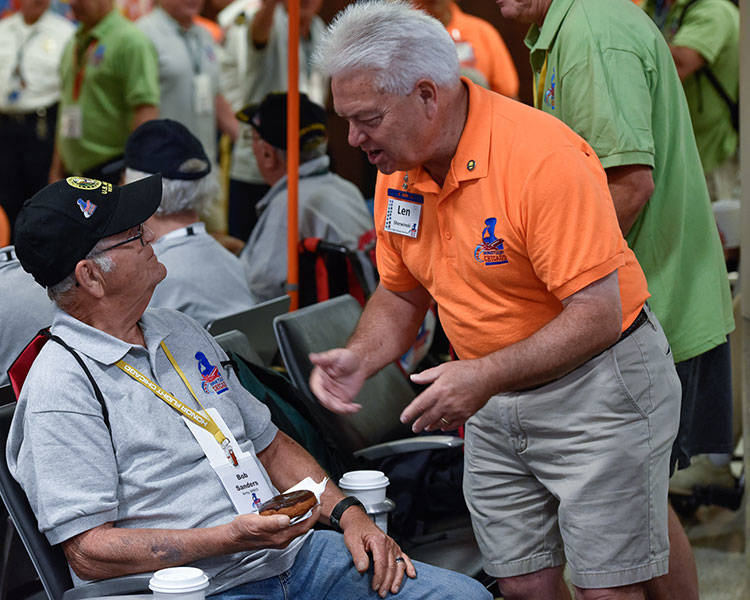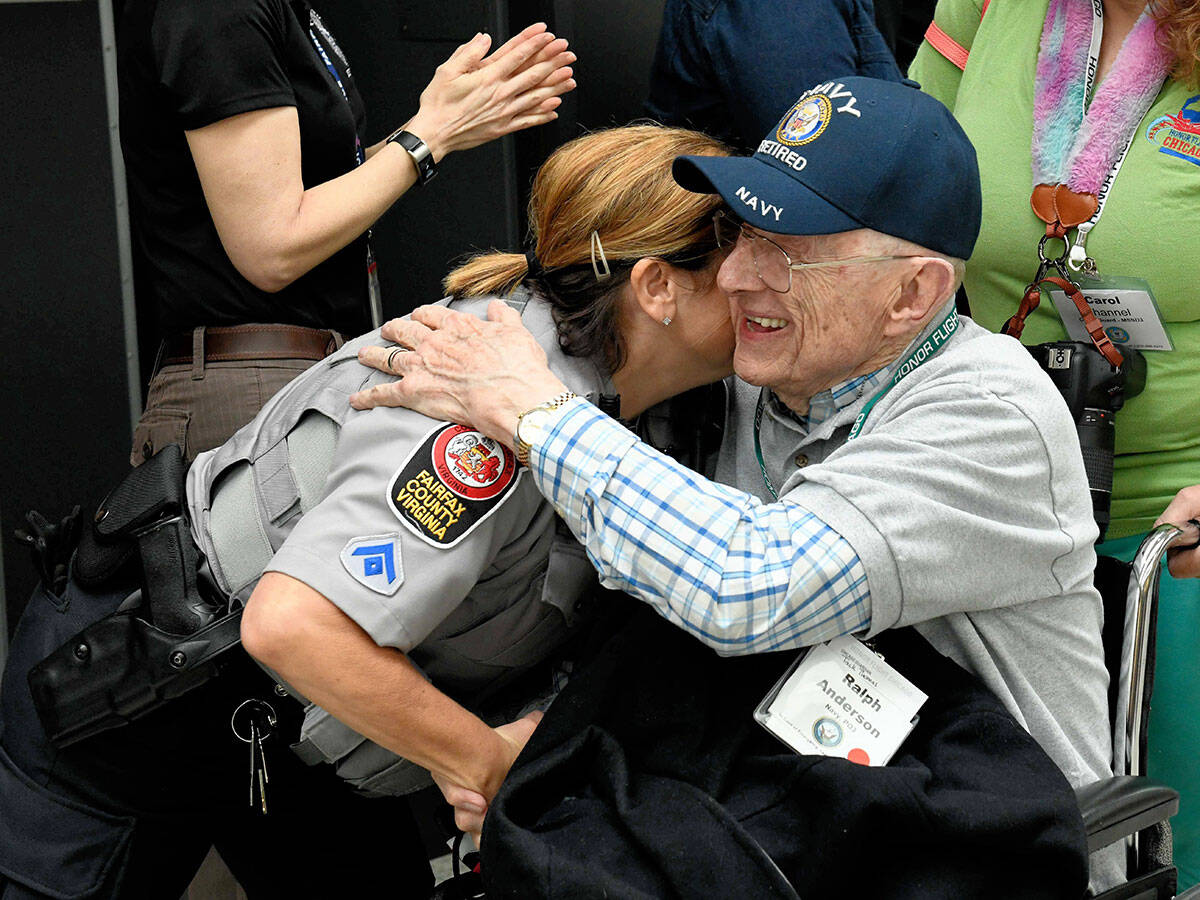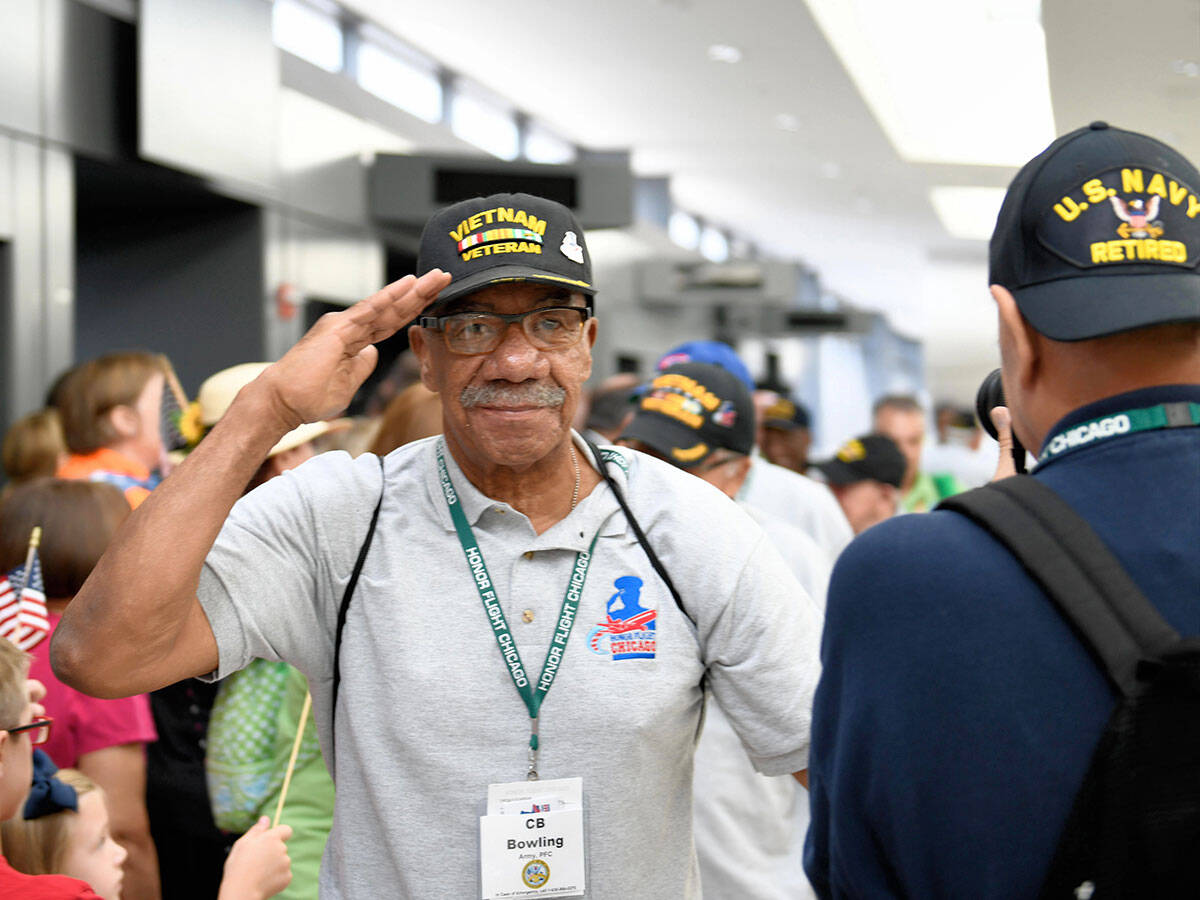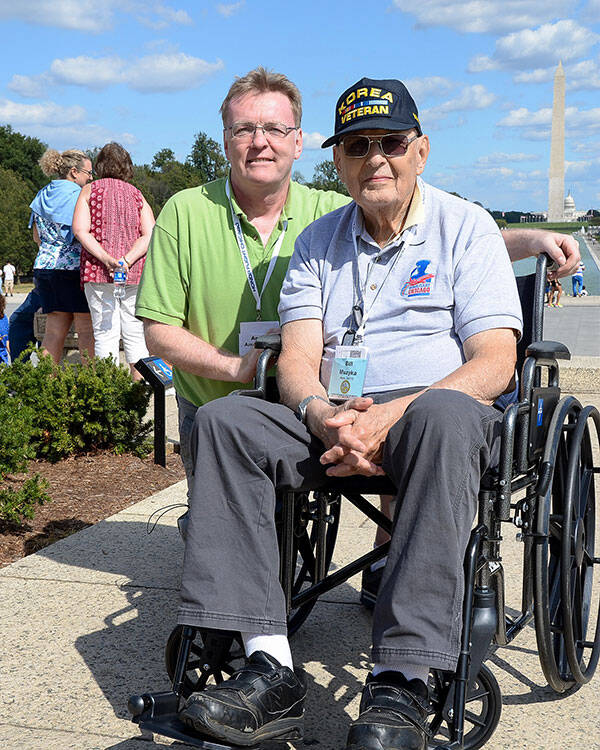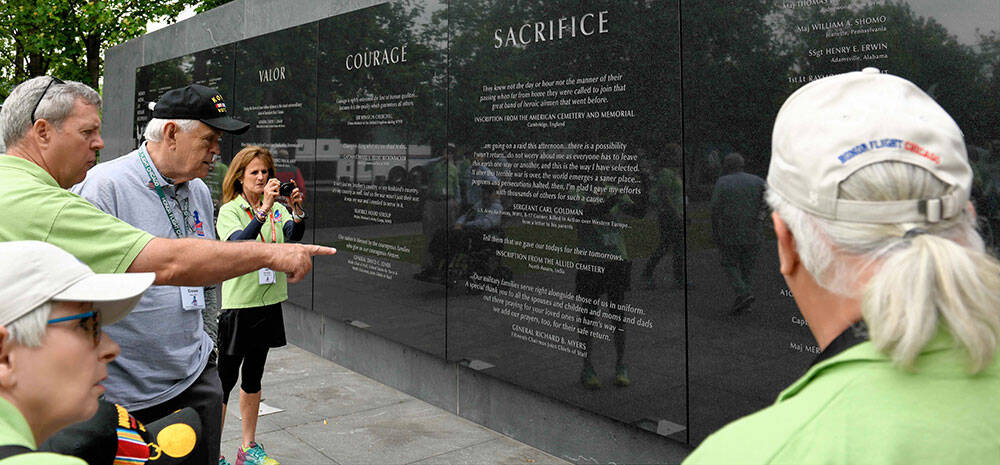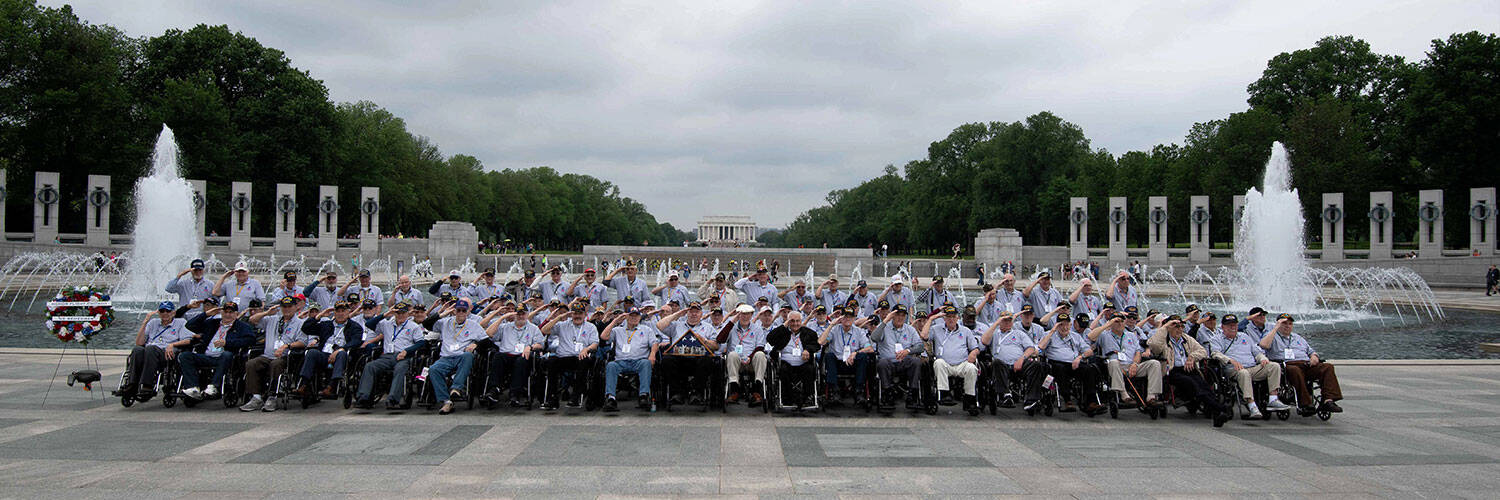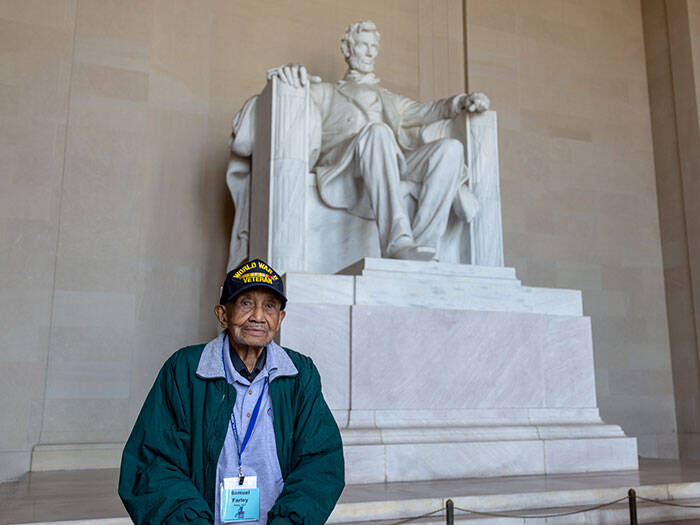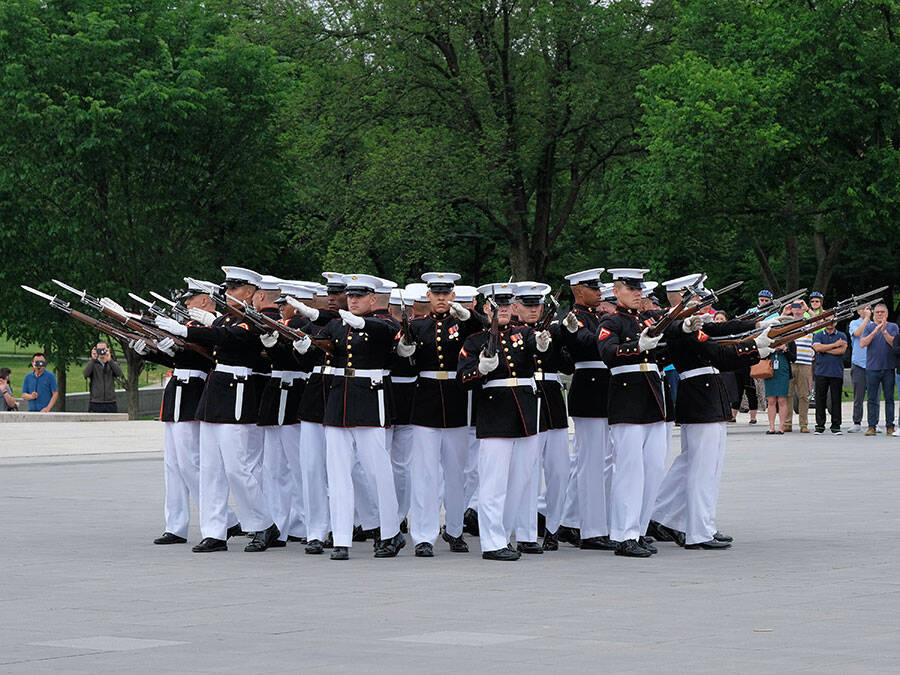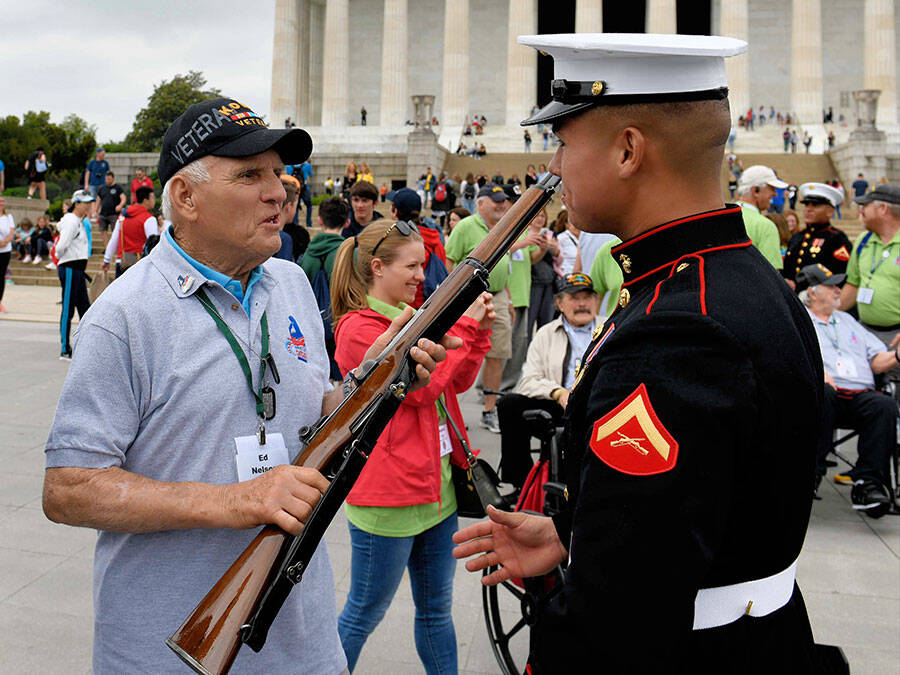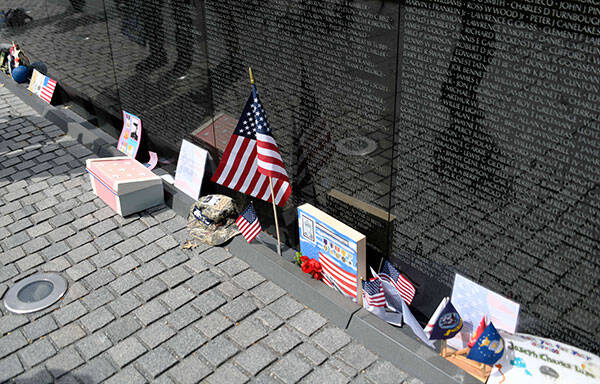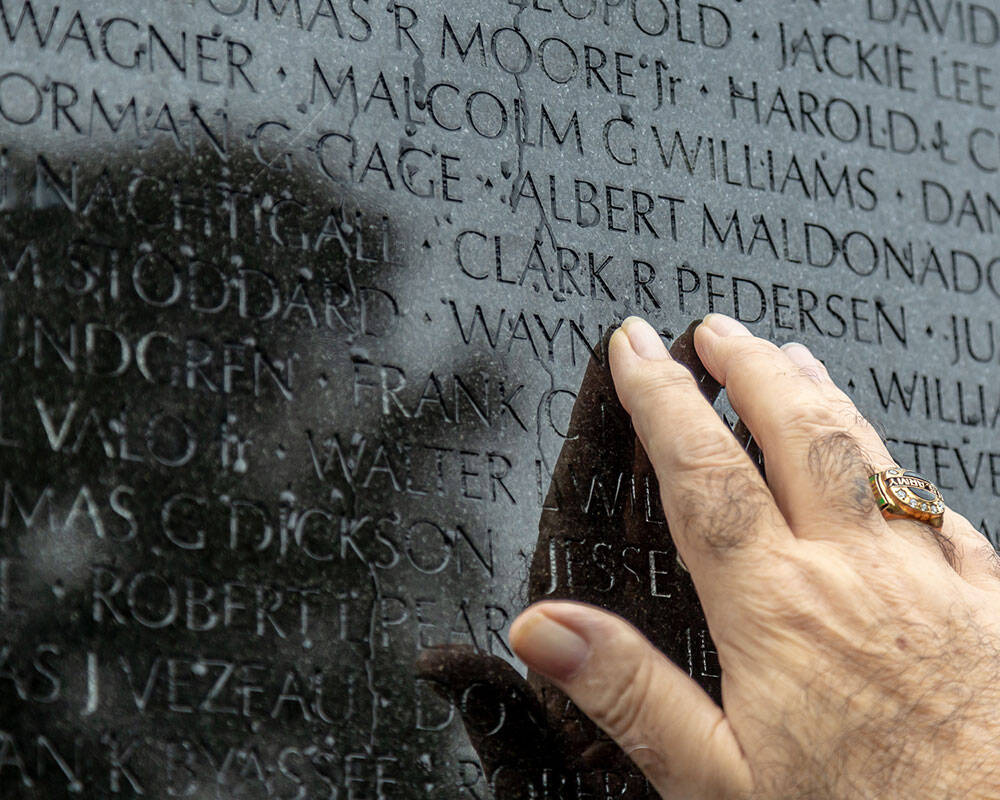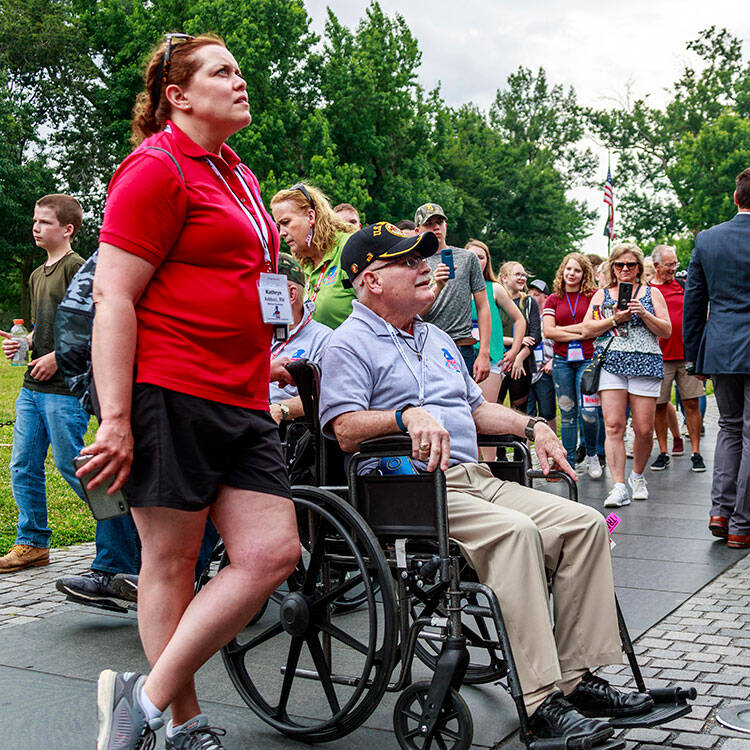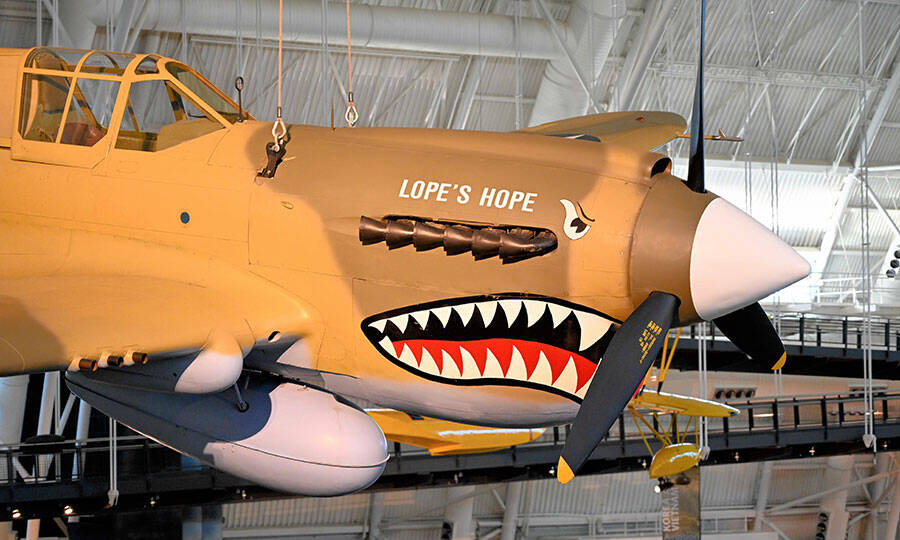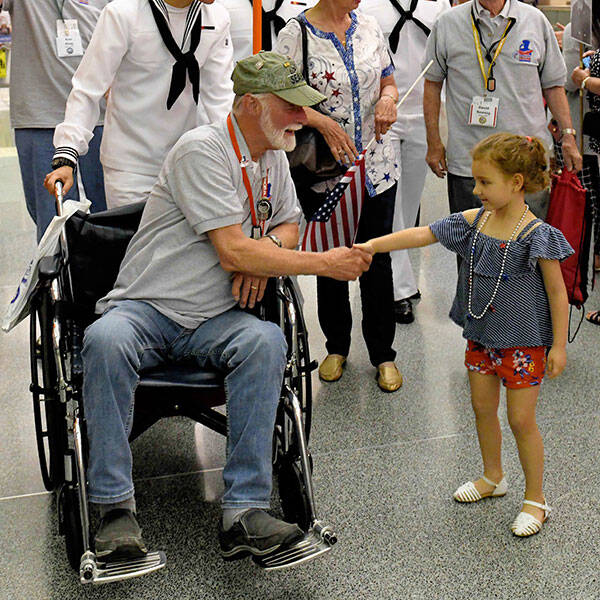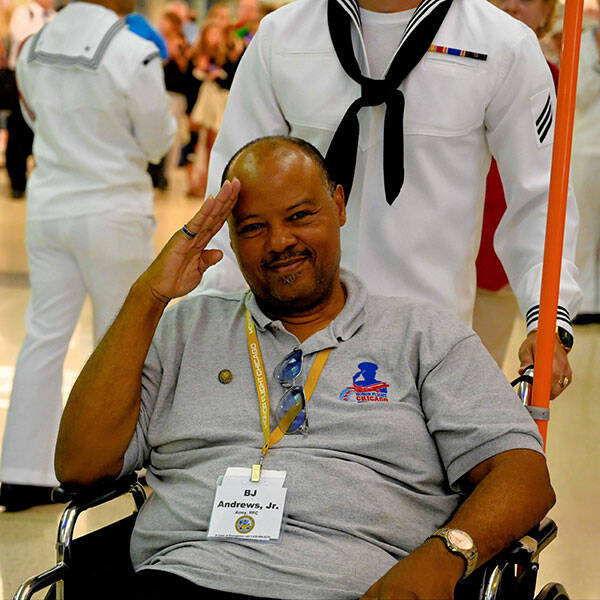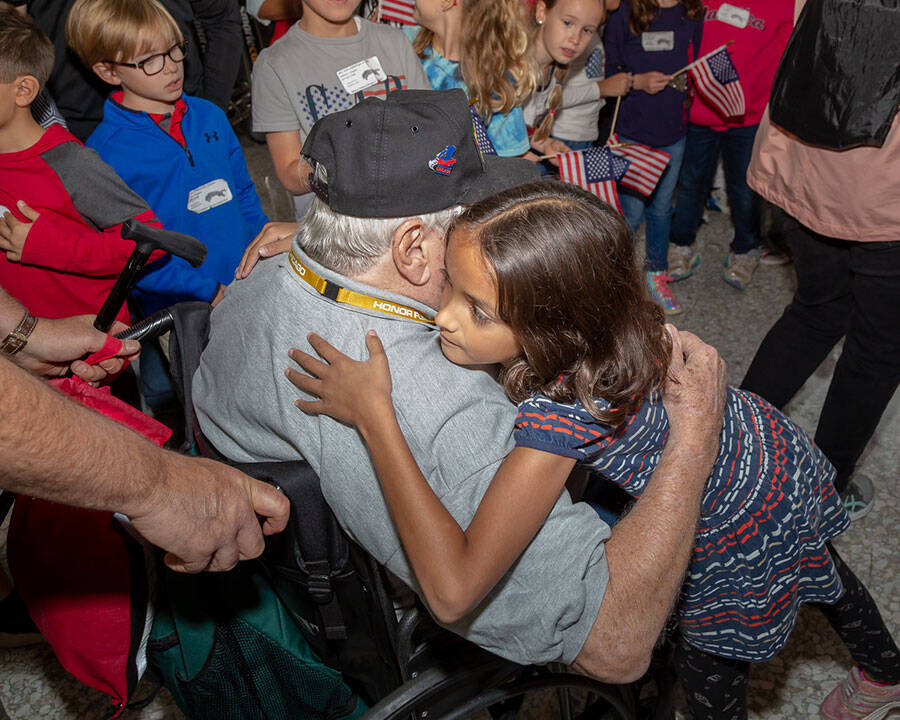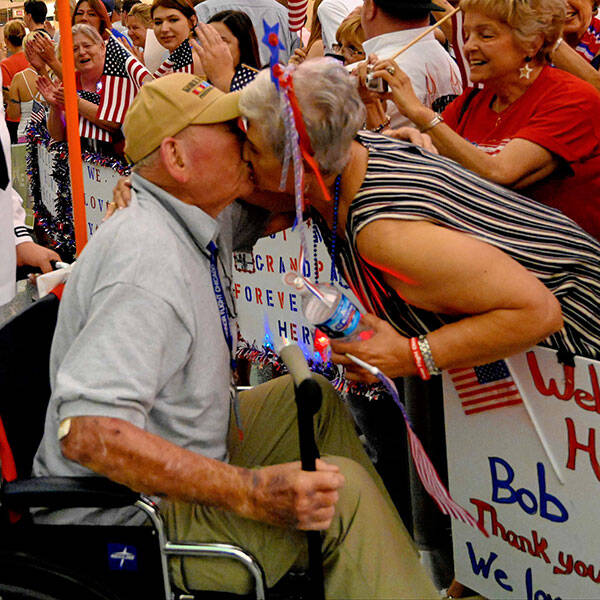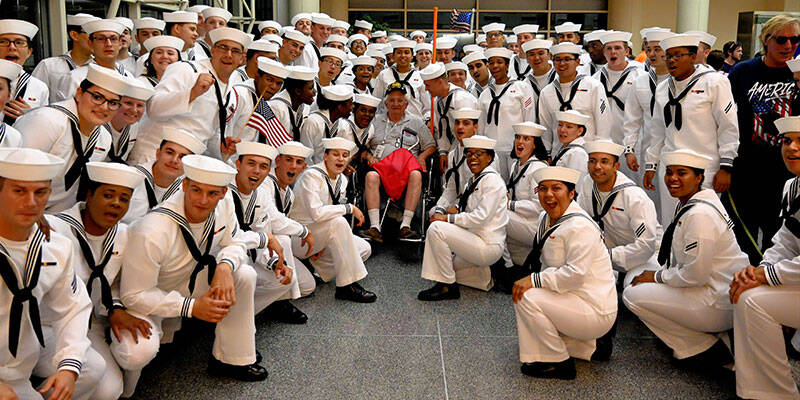Virtual Day of Honor
The 2020 Honor Flight Chicago season has been postponed due to the COVID pandemic, but our mission to Honor, Thank and Inspire our senior war heroes will continue. We will fly again when the time is right; every veteran currently on our waitlist and those who continue to sign up will have a seat on a future mission to Washington, D.C.
Until that day comes when we can safely fly, our focus shifts to different ways we can make certain that our veterans – both our alumni and those who still await their deserved Day of Honor – feel the appreciation, respect, and love that they earned through their service to our country during a time of war.
With that in mind, we are excited to offer the following Virtual Day of Honor. Scroll through this page to embark on a digital journey to Washington, D.C., and get just a taste of what our missions encompass. Thank you for your service. And Welcome Home!
EARLY-MORNING ARRIVAL: 4 A.M.
The day begins long before the sun rises. By 4 a.m., approximately 100 senior war heroes come together in the baggage claim area of Midway International Airport. It’s early, but it’s still easy to feel the energy and excitement for the coming day.
Veterans are swiftly checked-in, where they hear two words that will be a common theme throughout the day: “Thank you.” These men and women are thanked for their service and then escorted to a designated area where they will meet some of their fellow veterans on the flight. They’ll receive an Honor Flight Chicago shirt and have their picture taken.
Honor Flight Chicago has flown 95 flights filled with World War II, Korean War and Vietnam War-era veterans to Washington, D.C., since 2008, so although the early-morning process is complex, it operates like a machine. That smooth beginning to the day is made possible by our incredible volunteers, some of who arrive at Midway as early as 2 a.m. to make sure everything is ready for our veterans.
Meet our volunteers
Simply put, Honor Flight Chicago would not exist if it were not for our loyal volunteers from Chicago and Washington, D.C. Each flight takes more than 1,500 hours to plan, prepare and execute, and the majority of that time is executed by volunteers looking to show their gratitude to our senior-most veterans.
HFC has a modest staff size, so we rely heavily on the contribution of our volunteers, and they never cease to amaze. We take pride when we hear people say they have never seen an organization with the type of devoted volunteers we have.
A rainbow of helpers
Honor Flight Chicago volunteers are distinguished by the color of their shirt. Our heroes all wear grey polo shirts to identify them as honored veterans on the trip. Get to know the other colors you’ll see throughout flight day.
WAITING AT THE GATE: 5:30 A.M.
WAITING AT THE GATE
Once everyone is checked in, our veterans are escorted by a volunteer from baggage claim up to the airport’s main concourse, through security and to our departure gate.
Once at the gate, our heroes are treated to a breakfast of fresh-baked donuts and coffee as well as USO-style entertainment from Sweet Reminder. These singers help transport our veterans back to their time in the service and set the mood for the rest of the day. It’s still early in the morning, but it’s routine to see some of our veterans dancing with volunteers and singing along with Sweet Reminder.
The combination of patriotic songs and jovial laughter is a sight to be seen, particularly for onlookers who are at Midway for travel of their own.
LEAVING FOR D.C.
By 6:45 a.m., our veterans are all boarded on their Southwest Airlines flight destined for Washington, D.C. When Honor Flight Chicago first began flying veterans in 2008, the plane was made up entirely of World War II veterans and their Guardians. In 2016, HFC began giving Korean War veterans their Day of Honor, and in 2019, the same honor was bestowed on Vietnam War veterans.
Flights today are made up primarily of Vietnam War veterans, but one of the most magical elements of flight day is witnessing the interactions among veterans from different wars. To have World War II, Korean War and Vietnam War veterans all sit beside one another on an airplane is an incredible opportunity for them to learn from one another and also is an inspiring sight for all the volunteers and HFC organizers on board.
There is a buzz of anticipation and excitement throughout the airplane, although admittedly, there are also some tired eyes. The quick flight from Midway to Dulles International Airport outside of D.C. is a great opportunity for our heroes to get some quick rest.
Since 2009, Honor Flight Chicago has given 8,728 veterans their day of honor.
Average breakdown of veterans on each flight
While World War II veterans make up the majority of heroes who have been recognized by Honor Flight Chicago, flights today comprise a majority of Vietnam War veterans. Honor Flight Chicago opened up seats for Vietnam War vets in 2019.
ARRIVING AT DULLES
When the plane lands at Dulles, our veterans are greeted by a water cannon salute from The Fire & Rescue Department at Washington Dulles International Airport, a gesture reserved only for heroes returning home. As the plane drives underneath the cascading war, cheers of appreciation ring out from onboard the plane.
Our veterans deplane and make their way out toward the gate’s boarding area. As they approach the doorway into the seating area, they are greeted by music and cheering. They walk out the door and are quickly welcomed by police, military personnel, young children and families of all sizes. The Fairfax City Honor Flight Band led by Geoffrey Seffens plays patriotic melodies as our veterans walk through one of two lines, shaking hands and being welcomed home by everyone they see.
This is a welcome home for these men and women, even though most are not from the area. Truly, it is a show of gratitude and appreciation. It is a sign of respect. It is a small way the public thanks them for their service.
Get to know our Guardians
Our organization is only able to do what it does because of our incredible volunteers. Each of our volunteer groups has an important responsibility throughout the flight day, and for our Guardians, that job is keeping our veterans safe and comfortable throughout the day.
Each veteran is assigned one Guardian for the day. Some of our Guardians fly with us from Chicago — oftentimes these are family members of veterans being honored. The rest of the Guardians come from a passionate group of volunteers based out of D.C., and these Guardians are paired up with their vets once the airport welcome is complete.
Boarding the bus
Our group of heroes is so large that we need five coach buses to fit them and their Guardians comfortably. Our veterans are assigned to one bus — red, white, blue, gold, or green — and that is the bus they will be on for the duration of the trip.
There is no significance in pairing veterans with their specific color bus, but it does serve as a great way for veterans to better connect with one another since they will ride together on the same bus throughout the day.
Once the group is fully boarded, the bus heads out from Dulles, ready to take these heroes on a journey to the memorials built in their honor.






MARINE CORPS MEMORIAL
The Marine Corps War Memorial, also commonly known as the Iwo Jima Memorial, is first on the list of sites our veterans see during the day. The statue replicates one of the most iconic military images in United States history, and it is a powerful way to start the D.C. tour.
Our buses do not actually stop at the Iwo Jima Memorial, but instead take a slow ride around the circle drive that encloses the memorial so that our veterans can see the memorial’s “optical illusion” of the flag being raised. The memorial is located near Arlington National Cemetery and allows our veterans to get a brief look at the final resting place for so many of the country’s fallen military members.

Picking up our police escort
With as many stops as we make during the day, it would be impossible to make it everywhere on our itinerary without some special assistance with D.C. traffic. Fortunately, local Park Police help out and give us a “rock star” escort through our nation’s capital, beginning after our look at the Marine Corps War Memorial.
AIR FORCE MEMORIAL
With our police escort leading the way, our group travels from the Marine Corps War Memorial to the Air Force Memorial, where our veterans get out for their first true stop of the day. The memorial, located in Arlington County, Va., was built in 2006, and for many of the men and women on our trip, this is their first time seeing the powerful tribute to all Air Force personnel.
Our veterans spend about 30 minutes walking around the memorial, pausing to take pictures with the bronze honor guard, reflect on the Air Force’s core values, and admire the stunning spires reaching up toward the sky. It takes a careful eye to successfully capture a photo of all three spires, and it not uncommon to see some of our younger veterans, or their Guardians, lying on the ground and staring up to try and get the perfect picture.
Did you know?
The Air Force Memorial was completed in 2006 and is located along the flight path used by American Airlines Flight 77 during the September 11 attack on the Pentagon. The plane struck a section of the Pentagon that was under construction at the time and largely deserted. Had the Air Force Memorial been present on that day, the attackers would have been forced to take a different approach, likely resulting in many more casualties inside the building.
WWII MEMORIAL
Next on our memorial tour is the World War II Memorial, which was dedicated in 2004. Located on the National Mall in D.C., this memorial is more centrally located than the Air Force Memorial. More tourists tend to be at the World War II Memorial, which tends to lead to memorable interactions for them when they realize they are in the company of approximately 100 senior war heroes — including some from World War II.
Veterans have time to tour the memorial before a ceremony. The rainbow pool is an iconic picture for anyone to take, but for many of the veterans on our trip, one of the frequent stops for photos is the granite column with Illinois carved into it.

Kilroy was here
The legend of how “Kilroy was here” started came from James J. Kilroy, a shipyard inspector during WWII. He chalked the words on bulkheads to show he had been there and inspected the riveting in the newly constructed ship. To the troops in those ships, however, it was a complete mystery — all they knew for sure was that he had “been there first.” As a joke, they began placing the graffiti wherever US forces landed or went, claiming it was already there when they arrived. The tradition continued in every US military theater of operations throughout and following WWII.
Honoring our heroes
Once our veterans have time to walk around the memorial, they gather in front the rainbow pool for a formal ceremony that recognizes their service and sacrifice. It is one of the more emotional moments of the day for many veterans. For onlookers, the site of 100 senior war heroes tucked close together, all saluting at the same time, is a moment that is hard to forget.
The ceremony includes an honor guard, soloist, and bugler, and is intended to honor ALL of our veterans on the trip along with their comrades-in-arms who made the ultimate sacrifice for our freedom.
The ultimate sacrifice
At the conclusion of the ceremony, we devote time to pay tribute to the men and women who paid the ultimate sacrifice for our freedoms. The World War II Memorial does this in a powerful way with its wall of 4,048 gold stars, each representing 100 service personnel who died or were assumed missing during the war.
Our day is about honoring and giving thanks to our veterans, but this part of the memorial, and this moment of reflection serve as a reminder of all the men and women who gave their lives for their country.

LINCOLN MEMORIAL
The longest stop of our day begins at the Lincoln Memorial. Located in between the Korean War Memorial and Vietnam Veterans Memorial, it serves as a perfect gathering point for the afternoon. On warm days, it also is a perfect location for an afternoon ice cream treat!
When we arrive at the Lincoln Memorial, oftentimes our veterans are escorted to a VIP area in front of the steps of the memorial to watch a special performance in their honor from the Marine Corps Silent Drill Platoon. After the performance, our heroes spend an hour and a half touring the Lincoln Memorial, Korean War Memorial and Vietnam Veterans Memorial.
Marine Corps Silent Drill Platoon
Honor Flight Chicago is fortunate to have a special relationship with the Marine Corps Silent Drill Platoon, which often performs for our heroes during their Day of Honor. The 24-person platoon performs a silent precision drill that is breathtaking to watch and exhibits the discipline and professionalism of the Marine Corps.
In some instances, the Air Force Drill Team will perform as part of our itineraries at the Air Force Memorial.
KOREAN WAR MEMORIAL
One of the unique aspects of the Korean War Memorial is the personalized feel it gives, particularly to veterans who served during that time period. The faces of each of the 19 statues stare off into the distance, but routinely on each flight, we hear from our veterans that they see themselves in the statues.
The Wall of Remembrance helps put faces to the conflict and makes visitors feel more connected to those who served. In some instances, these images don’t just make our veterans feel closer to their fellow servicemen — they make them feel as though they are looking in a mirror. We have on occasion found that veterans gaze at the faces on the wall and find an image of their younger self looking back.
Stories from the Memorial
While the Korean War Memorial is important to our veterans, it also is significant for Koreans. We have frequently seen Koreans who are visiting the memorial go out of their way to come and greet our veterans and shower them with gratitude for their service and sacrifice.
“I was sitting and a lady with three daughters stopped and spoke to me. She saw that my cap said Korea on it and she mentioned she was from Korea. I said ‘Good Morning’ to her in Korean and she was so excited and she thanked me for my service in her country. Then she asked me if her three daughters could have their picture taken with me. She took several, then I told her again in Korean to have a good day (those are the only two sentences I remembered in her language). She really made my day, and I believe that I made hers.”—Earl Nordmeyer

VIETNAM VETERANS MEMORIAL
The Vietnam Veterans Memorial just might be the most iconic military memorial in Washington, D.C., and in 2019, it took on added importance to Honor Flight Chicago as we began flying veterans who served during the Vietnam War era.
Each person has their own feelings about the Vietnam War, and that varying perspective is apparent as veterans focus in on the thousands of names carved out before them. Some vets look for individual names on the wall — fallen comrades they never were able to say goodbye to. Others are too overwhelmed by the memory to even step within three feet of the wall. No matter the reaction, the point of the visit is to show our gratitude to these veterans while allowing them to show their appreciation for those who did not come home.
Scenes from the Wall
The story of rubbing names
One of the ways to permanently commemorate the trip to the Vietnam Veterans Memorial is by rubbing a name from the wall onto a sheet of paper with charcoal. Veterans are able to rub names on their own, or they can request that their Guardian or a memorial volunteer etch it on their behalf. The Vietnam Veterans Memorial Fund allows individuals to request a name be rubbed online and the final rubbed version can be sent via mail, though this option is currently not available due to COVID-19.
UDVAR-HAZY CENTER
Our final stop of the day is the Steven F. Udvar-Hazy Center — the Smithsonian National Air and Space Museum’s annex at Washington Dulles International Airport. This is traditionally one of our most popular stops, as the museum houses the Enola Gay, the Space Shuttle Discovery, a Lockheed SR-71 Blackbird and fighter aircraft and helicopters from throughout our nation’s military history.
Our veterans can either roam through the massive display area on their own, or they can take tours from the talented docents on site. It is common for some of our veterans to find versions of the planes they flew during service. While each veteran decides what route to take through the museum, they all tend to make it over to the Discovery, where visitors are often overwhelmed by the sheer size of the space shuttle.
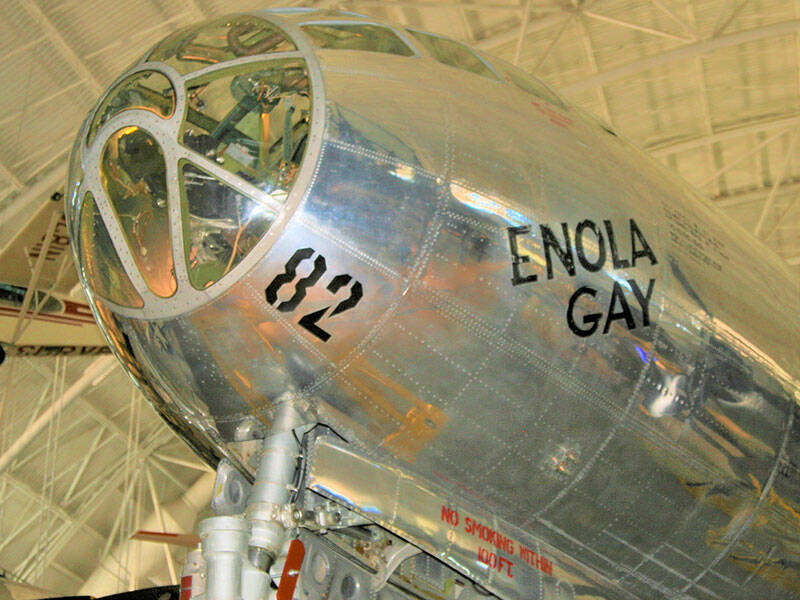
The history of the Enola Gay
Boeing’s B-29 Superfortress was the most sophisticated propeller-driven bomber of World War II. It was the first bomber to house its crew in pressurized compartments, and although it was designed to fight in the European theater, the B-29 became popular in the Pacific, where B-29s delivered a variety of aerial weapons: conventional bombs, incendiary bombs, mines, and two nuclear weapons.
On August 6, 1945, the Enola Gay dropped the first atomic weapon used in combat on Hiroshima, Japan. Three days later, the U.S. dropped a second atomic bomb on Nagasaki, Japan. The Enola Gay flew as the advance weather reconnaissance aircraft that day.
Information from the Smithsonian National Air and Space Museum website.
Space Shuttle Discovery
The Space Shuttle Discovery flew 39 missions between 1984 and 2011 — that is more missions than any other space shuttle. Learn more about the space shuttle below (information from the Smithsonian National Air and Space Museum website):
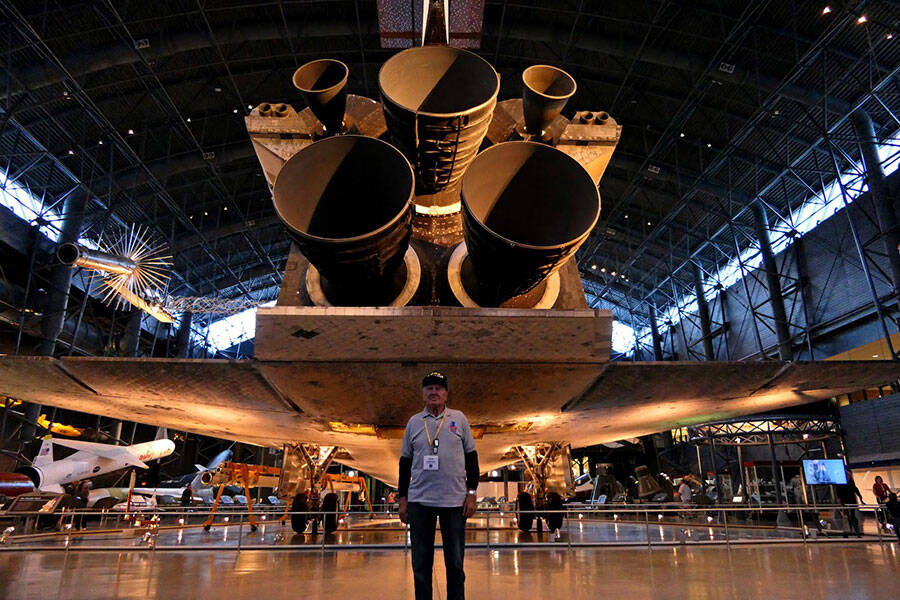
BACK TO CHICAGO
After dinner at Dulles and some complimentary entertainment by the dancers from Gotta Swing, LLC, it’s time for our veterans to head back home. Even after a long day in Washington, D.C., the flight home is generally buzzing with activity and excitement.
Little do the veterans know that there is one big surprise waiting for them in Chicago!
WELCOME HOME
We have found that there is no better way to say thank you than with thousands of your closest friends and family! And that is exactly what we do for each of our veterans.
When the plane lands at Midway, it is again greeted by a water cannon salute. From there the veterans deplane and are escorted up the jet bridge to the main concourse. As the veterans get closer to the gate, they begin to hear what sounds like raucous ovations. Once they leave the ramp and enter the gate area, they see what all the commotion is. Family, friends, sailors, and total strangers line up along the main concourse hallway to greet them, cheer for them, thank them for their service, and ultimately welcome them home. That last gesture is one that many of these veterans never received, and some have waited upwards of 60 years to hear that simple refrain: Thank You, and Welcome Home.
Our veterans are then escorted down the main concourse and toward the front of the airport, where another throng of people wait anxiously to show the thanks and gratitude these veterans so richly deserve.
We wish we could have flown a normal flight schedule this year, but as we’ve said throughout the current pandemic, we will fly again when the time is right. Until then, we hope you’ve enjoyed our virtual flight day. Thank you for experiencing it with us.
TO OUR VETERANS, THANK YOU FOR YOUR SERVICE!








